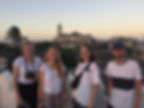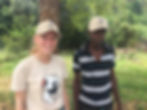One Tropical Island, some Red Monkeys = My Summer of 2019 - by Carys L'Estrange
- ZRCP
- Nov 5, 2019
- 3 min read
Guest post by Carys L'Estrange (Bangor University)
With thanks to the Bangor Fund for supporting undergraduate field research.
Inspiration
After travelling to Uganda, as part of the primatology field course module at Bangor University, I felt inspired by the work that I participated in during the small amount of time I spent there, including data collection and designing our own projects.
This is where my, now supervisor, Alex first mentioned the possibility of being able to design my own dissertation projects collecting 'real' data out in the field spending two months on the amazing Island of Unguja, Zanzibar!
Upon my return to the UK I couldn't stop thinking about the possibility of working with primates again, collecting proper behavioural data for a project that I can design myself.
Let the project begin!
After months of preparation on the 1st July I landed along with Kate, Zoe (also Alex's undergraduate students) and Harry (Alex's masters student) in tropical Zanzibar! I felt nervous as ever but super excited to be conducting my own research for the first time!

My Research Question
I based my research question on feeding ecology and maternal investment. These are two areas that I found, through being in Uganda and reading primate papers, that I was continually drawn too. So I thought it would be interesting to link the two together somehow.
I wanted to understand if female Zanzibar red colobus changed their feeding behaviour in any way as they raised their offspring. To do that I would observe both females without dependent infants, and females with infants of varying ages. Did they spend more or less time feeding when they were also suckling a small infant? Did this change as the infant grew bigger? If they increased their feeding time, what other activities did they sacrifice? Or did they change the composition of their diet somehow (i.e., the foods they ate)? I was also going to compare whether mothers or non-mothers changed their use of habitat - did they spend more time moving through the canopy? Did they travel further or less?

When first born, the infants have black hair, which they keep until about 3 months, before they change colour to red. Once red, I used their relative size to tell whether or not they were an infant or a juvenile. This was tricky at first but telling the approximate age of my study subjects in this way became much easier with practice!
Pilot study
During the first week on the island, I spent practically every day with the monkeys. Deciding my 2 study groups, identifying females and becoming familiar with data collection methods, ready for official data collection to start!

Towards the end of this week schedules were decided. I would spend 5 days per week in the field collecting my data, spending equal amounts of time with my two study groups. During the 2 days off, I enjoyed some well-earned rest, started organising my data and even had a chance to explore the island!
Official data collection
After finalising methods with the help of Rashid (my field assistant), I started officially collecting data averaging on around 20 focal follows per day, obtaining behavioural data, specifically focusing on feeding activity and suckling bouts!

Being with the monkeys most days and focusing on specific individuals from each of the groups, Camp and Half-Tail, Groups, I became so familiar with identifying females and their infants that the infant didn't even need to be around for me to know whether the female was a mother or not. This made data collection towards the end so much easier and less dependant on me spotting a if a female had an infant near her to know if she was currently a mother, like I did at the start!
What to do next?
From my 6 week experience in amazing Zanzibar, I have learnt so much more about primates in general and collecting behavioural data in the field. From this trip of a lifetime, it also helped me realise what I wanted to do next.Before I left Zanzibar for the UK I felt much more settled than I thought I'd be with the concept of going, now knowing in my head that I wasn't leaving for good! I knew what I wanted to do next, a masters degree by research in the
field working again with the Zanzibar Red Colobus Project!

